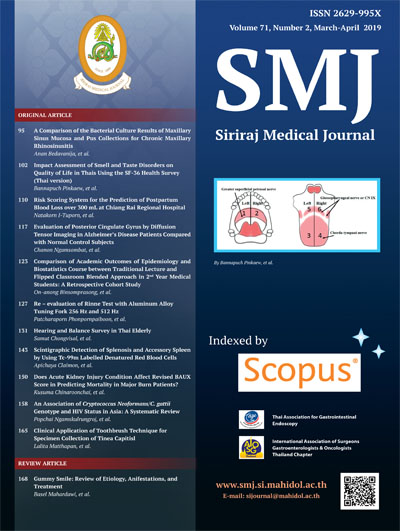Clinical Application of Toothbrush Technique for Specimen Collection of Tinea Capitis
DOI:
https://doi.org/10.33192/Smj.2019.25Keywords:
Tinea capitis; ectothrix dermatophyte infection; gray-patch type; toothbrush technique; hair-plucking techniqueAbstract
Objective: To demonstrate the efficacy of toothbrush culture test. Moreover, influential factors which affected the success of these methods were analyzed.
Methods: To retrospectively analyze clinical presentation and investigation data of 59 Buddhist novices who diagnosed TC. The laboratory data of the toothbrush technique was reviewed and the efficacy of this technique was investigated.
Results: The efficacy of toothbrush technique was demonstrated as 49.2% by comparing to the standard method. The analysis proved that more than 15% area TC involvement of scalp group achieved higher positive fungal culture outcome to be 65.5 % (p-value = 0.013). In the aspect of the clinical presentation, the effectiveness of the hairbrush technique significantly increased in the gray patch TC group (p-value 0.024). For the reason that the toothbrush technique demonstrated statistically higher efficacy in a group of patients with > 15 % gray patch area involvement (p-value = 0.007).
Conclusion: The toothbrush technique was a good cooperation method that was recommended to apply in TC patients who presented as gray-patch type and more than 15% scalp area involvement.
Downloads
Published
How to Cite
Issue
Section
License
Authors who publish with this journal agree to the following conditions:
Copyright Transfer
In submitting a manuscript, the authors acknowledge that the work will become the copyrighted property of Siriraj Medical Journal upon publication.
License
Articles are licensed under a Creative Commons Attribution-NonCommercial-NoDerivatives 4.0 International License (CC BY-NC-ND 4.0). This license allows for the sharing of the work for non-commercial purposes with proper attribution to the authors and the journal. However, it does not permit modifications or the creation of derivative works.
Sharing and Access
Authors are encouraged to share their article on their personal or institutional websites and through other non-commercial platforms. Doing so can increase readership and citations.















